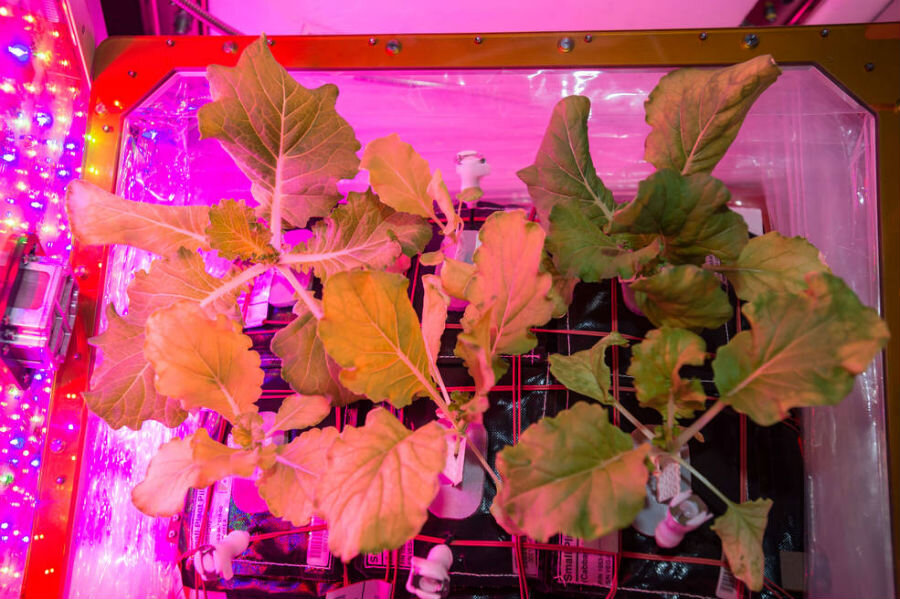Why NASA is expanding its 'Veggie' space program
| search for solutions
Like any good parental figure, NASA is making sure its astronauts are eating their vegetables.
On Tuesday, an Atlas V rocket blasted into space from the Cape Canaveral Air Force Station, carrying a payload of supplies and scientific equipment to the International Space Station (ISS). Onboard was a relatively small, mini-fridge sized experiment known as the Advanced Plant Habitat (APH), which astronauts will use to expand their ability to grow vegetables and other plants on the station, some of which will end up on the menu.
The ability to raise plants in cosmic conditions has been a NASA priority for years. Future human expeditions to Mars would require a reliable food supply that would have to remain viable for extended periods both during the trip to, and on the surface of, the Red Planet. Experiments like APH will be an important testing ground for determining the optimal techniques for preparing veggies outside the confines of Earth, says Chris Wolverton, a professor of botany at Ohio Wesleyan University in Delaware, Ohio, who currently has a NASA grant to study plant gravity sensing on the ISS.
"In the near-term, most experts expect astronauts will take the food they need for basic sustenance with them from the Earth," Dr. Wolverton tells The Christian Science Monitor in an email. "Plants, especially leafy greens, are experts at taking up chemical elements and creating vitamins and other micronutrients that humans need to stay healthy."
The new Advanced Plant Habitat is actually an expansion of a previous NASA initiative from 2015, known as the Vegetable Production System (dubbed "Veggie"). The Veggie program soon produced lettuce for the ISS crew, the first food grown by NASA in space specifically for astronauts to eat.
The success of Veggie encouraged scientists to go even farther with the APH initiative. While the Veggie system relied on enclosed plants processing unfiltered air from inside the station, APH will allow astronauts to more fully control the environment inside the growing chamber. APH will also be equipped with a brighter array of LEDs, including diodes that emit white and infrared light, to potentially quadruple the output of the Veggie system.
"It's really a way for the scientists to modify the environment: the light, the water, the atmosphere," program manager Bryan Onate told reporters in March, according to USA TODAY. "We'll learn a lot of invaluable information as we move on beyond low Earth orbit and move out to Mars and do food production out there in the future."
Of course, APH won't be useful just for the dinner table. The unit comes equipped with an array of sensors and cameras to monitor plant growth and provide information on how plants adapt to a non-terrestrial environment. Microgravity, radiation, and other space-related factors can affect the growth of living organisms in unexpected ways, and scientists don't want to be taken by surprise if future astronauts are relying on a space-based crop as an essential food source.
"One of the major problems with growing plants in a microgravity environment relates to the distribution of water, which tends to form droplets rather than flowing through the growth substrate," says Wolverton. "These droplets can have the effect of local 'flooding' when they form around plant tissue, effectively suffocating the plant, which requires oxygen."
And that's just a start. Without normal earth gravity, plants can even have trouble telling which way is up, he adds.
"Gravity is a major signal to plants that tells them which way to grow," says Wolverton.
The APH system comes with two varieties of seeds for the first round of experiments. First, astronauts will attempt to grow arabidopsis, a small mustard and cabbage relative considered a weed in its native Eurasia, then dwarf wheat, as a way to test the performance of the new unit. If all goes as planned, arabidopsis will be the main crop for APH's first experiment, which has been designated Plant Habitat 1.
Eventually, scientists hope astronauts will be able to use the unit to grow larger and more nutrient-dense plants. But ultimately, the goal of APH and other projects like it is simply to determine the viability of plant growth in environments other than Earth in preparation for Martian expeditions, says Edward Guinan, a professor of astronomy and astrophysics at Villanova University in Pennsylvania.
"To grow plants in Mars' cold climate, plants will need to be sheltered in greenhouses," Dr. Guinan tells the Monitor via email. "The amount of sunlight (solar radiation) on Mars is about 50 percent of that of the Earth since Mars is 1.5 times further than the Earth from the Sun."
Lack of light, increased radiation, and inhospitable Martian soil could pose significant challenges for plants on an alien world. But without experimentation, there's no way to know for sure how Earth vegetables would react to a Martian environment.
"Certain plants might do better than others," Guinan adds. "The experiments on the International Space Station (ISS) will help answer some of these questions."







